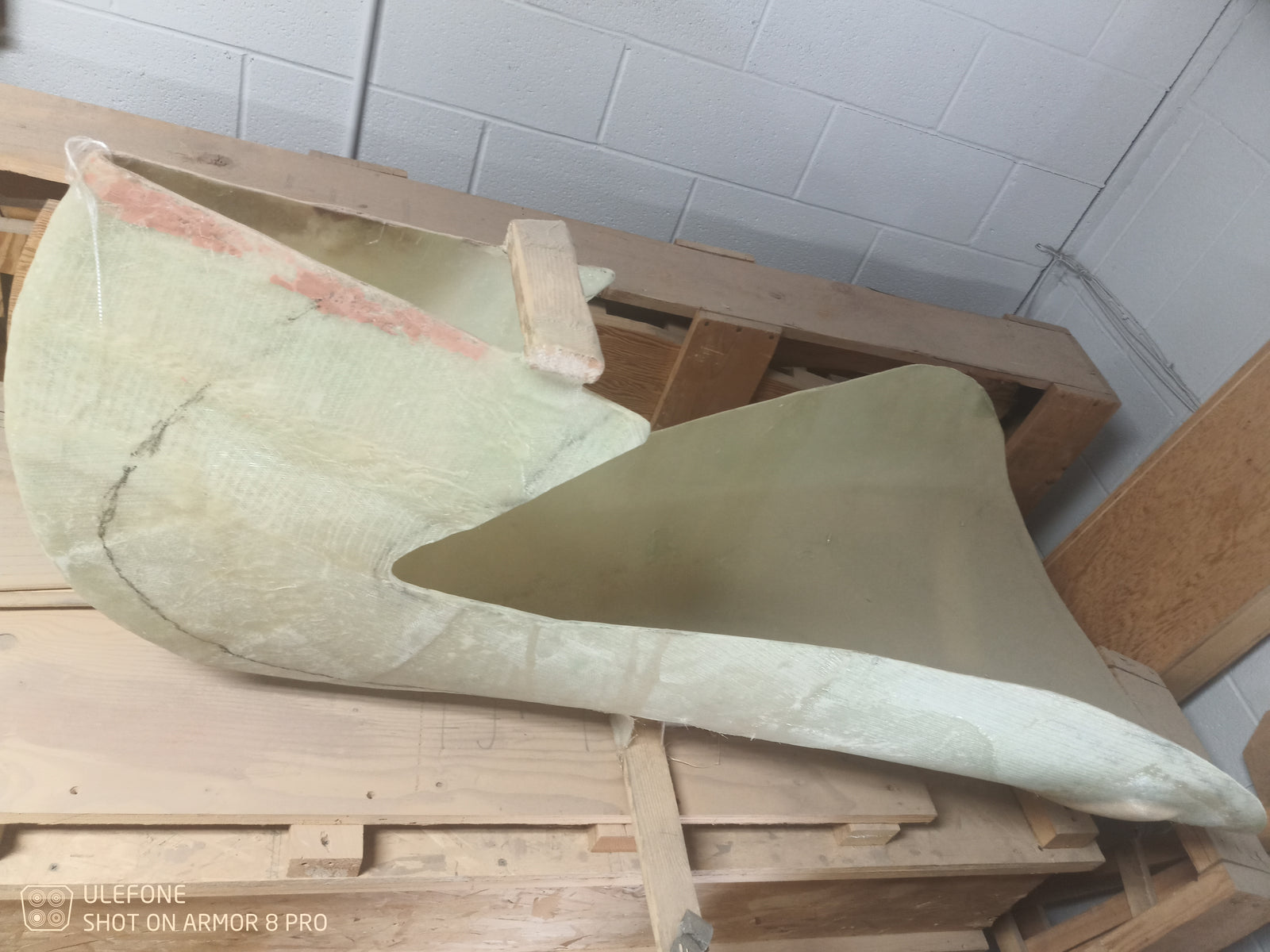Handmade. Adventure Ready.

Tips on Mold Making with Tooling Gel Coat and Polyester Resin
June 06, 2024 8 min read
MOLD MAKING:
The chart below begins with the plug at the centre. Following the layers towards the top is the mold making steps, and following the list to the bottom is the part lay up steps.
6- Any part that spans more than 16 inches requires a rib structure (plywood, composite, foam or additive)
5- Multiple layers of CHOP STRAND MAT until the mold is rigid
4- Polyester Resin + MEKP + Fibreglass Cloth (woven cloth for rigidity and heat warp reduction.)
3- Tooling or Unwaxed Polyester Gel Coat + MEKP 1% V/V 3mm Thick Layer
2- PVA 2 Layers: Is removed with the part and washed away with warm water
1- Partall Paste or Wax 2 Layers: protects mold from damage
PLUG : ideal shape and rigid to not deflect, twist, warp
- Make the plug perfect in stead of remaking or fixing the mold. You cannot differentiate repairs done in the mold until you pull a test part to see the corrections.
1- Partall Paste or Wax 2 layers
2- PVA 2 layers
3- *** Clear Gelcoat, Unwaxed Gel Coat or Pigmented Epoxy into mold
4- Begin Lay Up : Polyester Unwaxed Resin and MAT + 1708
or
Epoxy with Woven Fibreglass + Carbon Fibre + Kevlar + 1708, ETC.
5- Allow to Fully Cure or Post Cure depending on Resin
6- Check Quality (air bubbles, refinishing, polishing, weave adjustments and mold maintenance.)
The technicians at Timber Boatworks receive many phone calls and in store questions about mold making using Polyester Resin and Tooling Gel coat to make short production run parts (between 1-10 uses) or duplicating damaged composite parts. To help give some guidance I have made a chart of how the application layers from the plug (original shape that the builder is duplicating) to the mold making to the actual production of the final part. It must be stated that mold making for larger production runs without having to repair the mold surface do require composite panel or aluminum milled molds which are very expensive, so the polyester mold making process is more common but they do not necessarily make super durable long production run molds due to the limitations of tooling gel coat on polyester resin backings.This blog post is a simple guide that can be used alongside Youtube tutorials to make a first time mold maker and will help to avoid some of the simple pit falls that a first time builder may not have considered when only watching a Youtube video.
Disclaimer: We must note at this point the difference between personal use mold making (making a mold of a pre-existing part or product to fit another manufactured part ie: car parts, motorcycle parts) and a production part for resale. It is most common for people to take a manufactured part and use it to make a mold, and for personal use this is no issue, but duplicating a patented or copyright part and reselling as the individuals part has legal and economic repercussions. Follow the copyright and patent laws if you are making a new product for resale.
A distinction must also be made between single part and two part (or more) molds. If the plug has less than a 90 degree shape without flanges or great round shapes one part molds can be used. If the part is more complex with curves, flanges, 90 degree corners, etc., a two part mold must be made so the mold can be released from the complex shape below. This does require more consideration and planning, but most molds are two part or more molds that are joined to make the part.
The plug is the most important component of mold making because without an ideal shape, rigid and smooth plug the mold will just duplicate any faults, inconsistencies, warps and surface textures of the plug which ultimately makes every part have these same issues.The more time spent on the plug and the more rigid the plug is the better the tooling gel coat surface and the better result for the final part. Changes made to the plug are easy in comparison to making changes to the mold surface or refinishing the final part everytime, so take the time and care to make the plug perfect.
The mold making process using tooling gel coat and polyester resin generates quite a lot of heat as the resin cures, the resin has shrinkage as it cures and can be quite heavy when applied for appropriate strength. All of these factors will put pressure, heat and tension on your plug which can cause it to deform through the cure, which makes the part different than the original plug. This can cause parts not to fit or make them prone to damage if they have structural curves (etc) that are not a correct shape. This is mostly a factor when copying plastic or metal parts because the heat defection of these materials will make them change shape. The metal will expand while the tooling gel coat shrinks and this causes tooling gel coat cracking. Plastic warp and elongate while losing strength if they are heated, so the mold will be a very different shape than the plug.
https://boatcraft.com/collections/gel-coat/products/orange-tooling-gel-coat?variant=40351864455248
https://boatcraft.com/collections/polyester-resin
Composite plugs are the best for duplication because they are make of the same or similar material to the tooling gel coat and polyester resin. The composite parts are more rigid and can easily be waxed and polished for the best mold surfaces. Foam constructed part are the most common, however they have to be reinforced with epoxy resin and fiberglass e-glass to have strength. Polyester resin and tooling gel coat will dissolve foam if applied directly. It is common on Youtube to see the use of Tuck Tape or other tapes over foam, the issue with only applying tape onto a surface is every ridge of the tape leaves a texture, which will make your mold surface textured. This leads to in mold refinishing. Heat shrink style plastics can be used for certain basic parts over foam, however they are easily scratched and damaged so the plug cannot be refinished, polished or handled without extreme care to not puncture the heat shrink materials.
There is also a distinction between veneering a preexisting part and making a female mold that you are laying composites into, veneering makes the visible surface the final layer of the lay up where mold making the finished surface is the bottom and first layer. We do get asked consistently for advice for on laying carbon fibre onto steel or aluminum car parts, but this is very different than using an aluminum part to make a female mold and then having the finished surface on the bottom layer. Veneering can be done using vacuum bag techniques and does require a large amount of refinishing for clear urethane top coating. Mold making over metal means that all of the welds, seems and grinding marks must be filled or removed to a smooth mirror finish before the mold release agents are applied. The risk to textures on metal surfaces is that the resins can bond or partially bond to the surfaces and not be removed without damaging the mold or duplicate textures into the mold.
Once the plug surface is ideal two layers of partall wax and two layers of PVA are applied. The partall wax protects the plug surface so if the mold making process fails the plug remains undamaged. Partall Wax has to be worked warm, so polishing with a buffer is required until the surface is mirror finished. Any textures from the partall or PVA will be duplicated on the tooling gel coat surface. PVA (polyvinyl alcohol) is a water soluble mold release agent that is removed from the mold surface with the part. The part is simply washed with water and all of the mold wax and contamination is removed with the PVA. PVA is sprayed in with a mist bottle and smoothed out with a foam brush. Now the plug is ready for the tooling gel coat application.
https://boatcraft.com/collections/mold-and-vacuum-supplies
Tooling gel coat is ISO polyester resin with high density particles and pigment, that when applied in a thick enough layer can be mirror polished for a non-porous surface for highly smooth parts. For the best result tooling gel coat is applied with a sprayer in 2 coats of 18 mils (.475 mm) per coat to reduce shrinkage. Read the Technical Data sheet for your specific tooling gel coat for proper application, catalysation and HVLP sprayer information. Tooling Gelcoats are often unwaxed isophthalic resin so Polyester unwaxed resin can be applied directly onto the tooling gel coat surface.
Polyester resin backing is applied over the gel coat to create stiffness in mold. Woven cloths such as e-glass or s-glass can be used with polyester resin to greatly increase the strength of the resin without adding many thick layers. If using chopped strand mat more layers must be applied and plywood or other backings must be installed and fiberglassed for parts that are more than a few square feet in size. The mold has to be rigid enough to handle the expansion and heat of the part when laying up the mold. Testing can be done to ensure that the mold is thick enough to handle the lay up, if your final part is also going to be a polyester lay up the mold has to be thicker and stronger than the final part so that the part does not damage the mold during the lay up. Seems obvious but thin molds and thick lay ups for the final part will destroy the mold when it expands and shrinks while curing.
Once fully cured the mold is complete and laying new parts into the mold is possible. Two layers of Partall wax and polished into the mold along with two layers of PVA are sprayed on the surface. Begin spraying unwaxed clear, white or pigmented gel coat into the mold. Begin laying saturated fabrics into the mold and remove all air bubbles from the cloths. Make sure that your resin system is compatible with your fiberglass, carbon fibre, kevlar or composite panel. Not all gel coats and clear coats are able to be used in mold. Once cured release the part from the mold with air pressure, hot water or cold water, do not pry the mold off the part with a screw driver. Wash the part in water and check quality and consistency against the plug. The part and the plug should be identical.
IMPORTANT:
- Dry Lay Up: laying fibreglass into the mold without saturating with resin or epoxy. This allows you to move the fibreglass around without damaging the mold release. One layer at a time until you have the desired strength.
- Wet Lay Up: Coating the surface with epoxy or resin before applying the cloth. Once the surface is tack free applying the fibreglass or composite. Saturating with more resin.
- Patterns: it is easiest to cut cardboard or paper patterns that are the exact shape of the internal mold surface area. Use the pattern to cut the exact shape out of your composite materials. When working with clear finish materials you will have the exact shape and weave you desire. Patterns are reusable and make the result consistent and easy to duplicate.
- Testing: it is easiest to build small test samples of your composite material. These samples can be tested to ensure that you have enough strength, weight, flex, heat resistance, impact resistance, etc. This will inform what your laminations should be in your actual product, as well as the expected final result.
Subscribe
Sign up to get the latest on sales, new releases and more …
